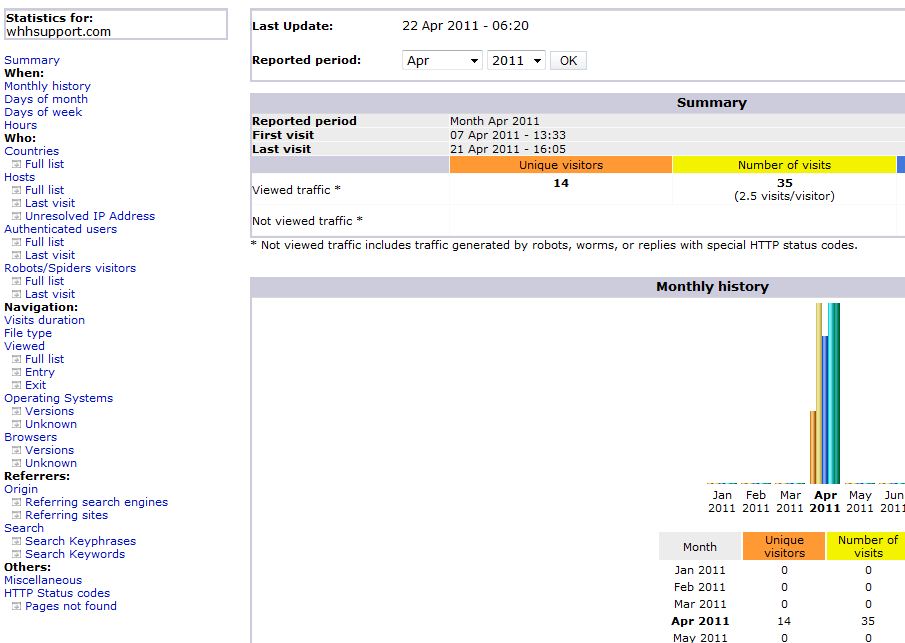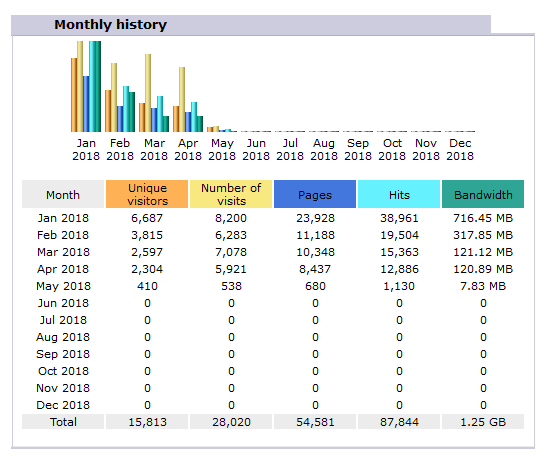

I'll bet the solutions to this problem is really simple and obvious. Do your pages contain other scripts that might interfere with the analytics script? Javascript errors in any of your pages might be an indication of this. Did you place the analytics script in either the HEAD section (not recommended) or BODY section (recommended - just before the closing tag)?Ĥ. Are you sure that you have the (full) analytics script in all of your pages? Do you for example have an admin section where you don't use analytics?ģ. Be sure to look at "Pages" - the number of page views - when you compare with analytics.Ģ. Are you looking at "Hits" in awstats rather than "Pages"? "Hits" count all requests to the server, including images. I doubt your prblem is related to disabled cookies or javascript but I can think of a few other reasons:ġ. I also use a combiation of analytics and awstats, and I find that they are very consistent and complement each other well.
#Awstats homepage full#
Or to put it another way, I think it is possible for a full page to be sent out by your server to a user who has already bailed out without cancelling, and you likely have no indication that's what happened. It might be when the user presses ESC and their browser explicitly terminates the transaction. If only a partial page is sent, the result is 206 (partial), but I'm not clear exactly what circumstances trigger a 206. If this is less than the file size, it was aborted for some reason.Īnother field is the result code, which is normally 200 (success). One of the fields in your raw server logs is the number of bytes transferred. If the request at least made it to the server, then it will be logged right away by the server and AWStats will report it even if the user bailed out early.
#Awstats homepage code#
Several people on this site have mentioned that, for this reason, they do not put the code in the head, but at the foot of the page.

The down side is that there's a noticeable latency every once in a while when loading pages seeded with Google Analytics tracking code Each method of tracking has its pros and cons (and sources of errors). Google Analytics script sets a persistent cookie to track user's navigation and visits regardless of the IP address - this is not possible by digging the server logs alone.īut makes it useless for this purpose for those who refuse cookies (and also those with JS turned off. Note that there is nothing stopping you from analysing the logs as well to see what the spiders are doing. If you are interested in page views that will have triggered the adsense code then Google Analytics will be more accurate in this respect (even down to not counting those visitors with javascript turned off who won't see adsense anyway!). You do not mention whether you consider this a good thing or not. Spiders and bots cannot execute Google Analytics code - this alone excludes a lot of traffic especially if you have Adsense on your pages. I guess you can continue using both in complementary aproach! Page tagging is adequate if you run ebusiness websites, or if you need to track your visitors behavior. it can also report on events which do not involve a request to the web server (flash action script.). The main advantages of pagetagging is that the javascript is called every time the page is loaded so you can track precisely your visitors behaviors even if they are loading the web pages locally from their cache. Anoher advantage is the fact that logfiles provides information about visits from search engine spiders and bots, failed requests which is really important if you want to optimize your website. and this data is on your server directly in standard format so you don't rely on a third party server.

every transaction is recorded by the webserver reguardless of the visitors browser. The main advantages of logfile analysis are the fact that the data is already logged by your webserver. Some browsers disable so me data collection for security reasons. Page tagging relies on the client (visitor) browser voluntarily providing the analytical information requested. file caching: if a returning visitor has file caching enabled on his web browser (usually it is the case) the request for the file he already viewed will not be sent to the web server, and he will view a local copy, so awstat will not detect multiple visits some times. the differences you see between the two solutions is due to two main factors: The second method, page tagging (Google Analytics), uses JavaScript on each page to notify a third-party server when a page is rendered by a web browser. The first method, logfile analysis (used by AwStats), reads the logfiles in which the web server records all its transactions. There are two main technological approaches to collecting web analytics data.


 0 kommentar(er)
0 kommentar(er)
